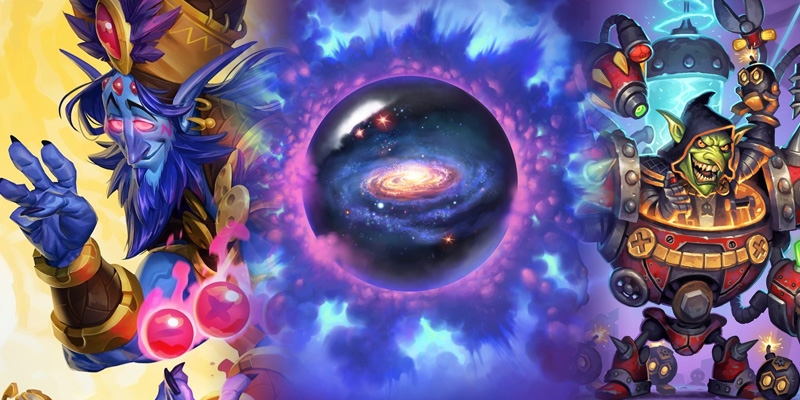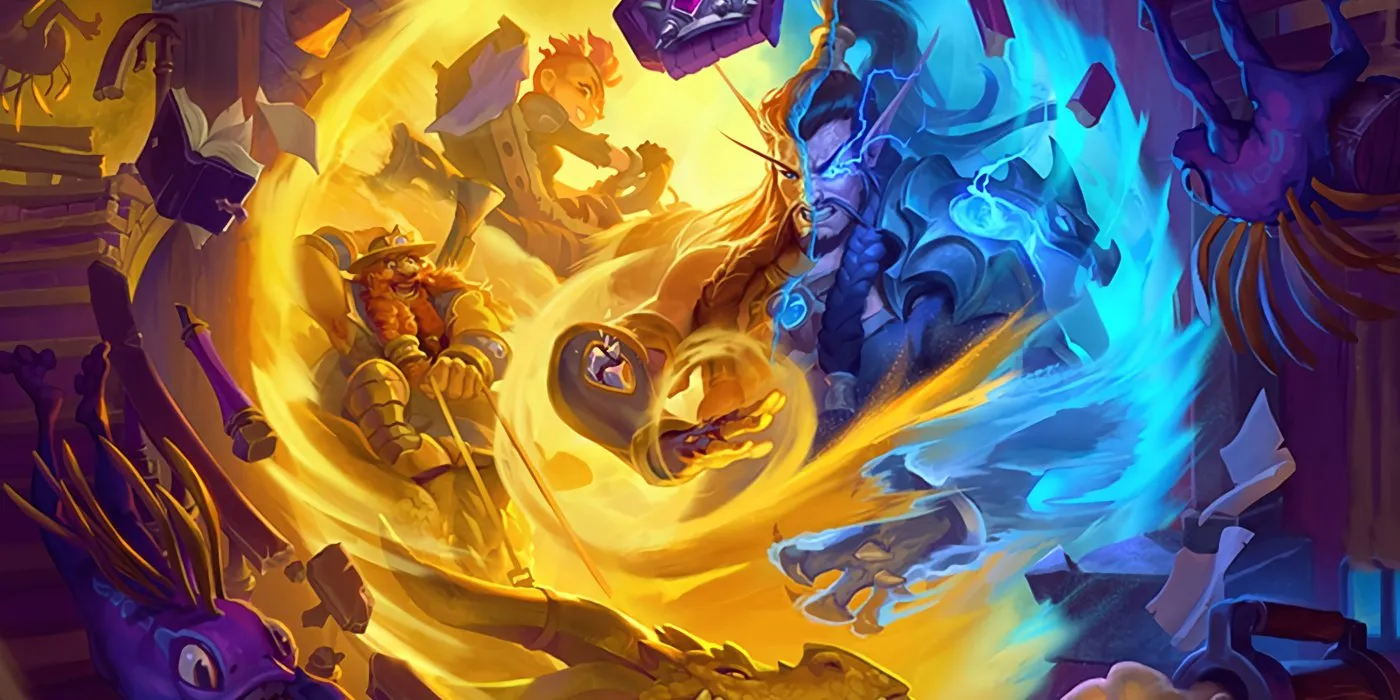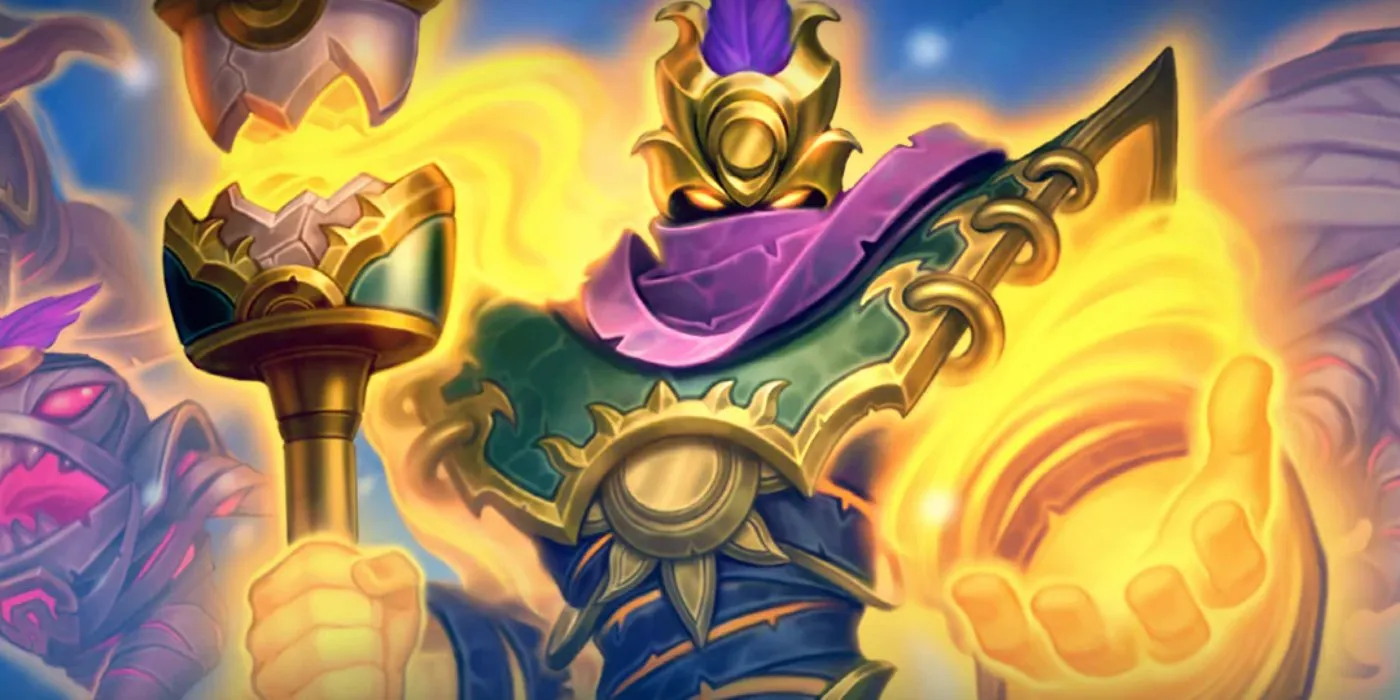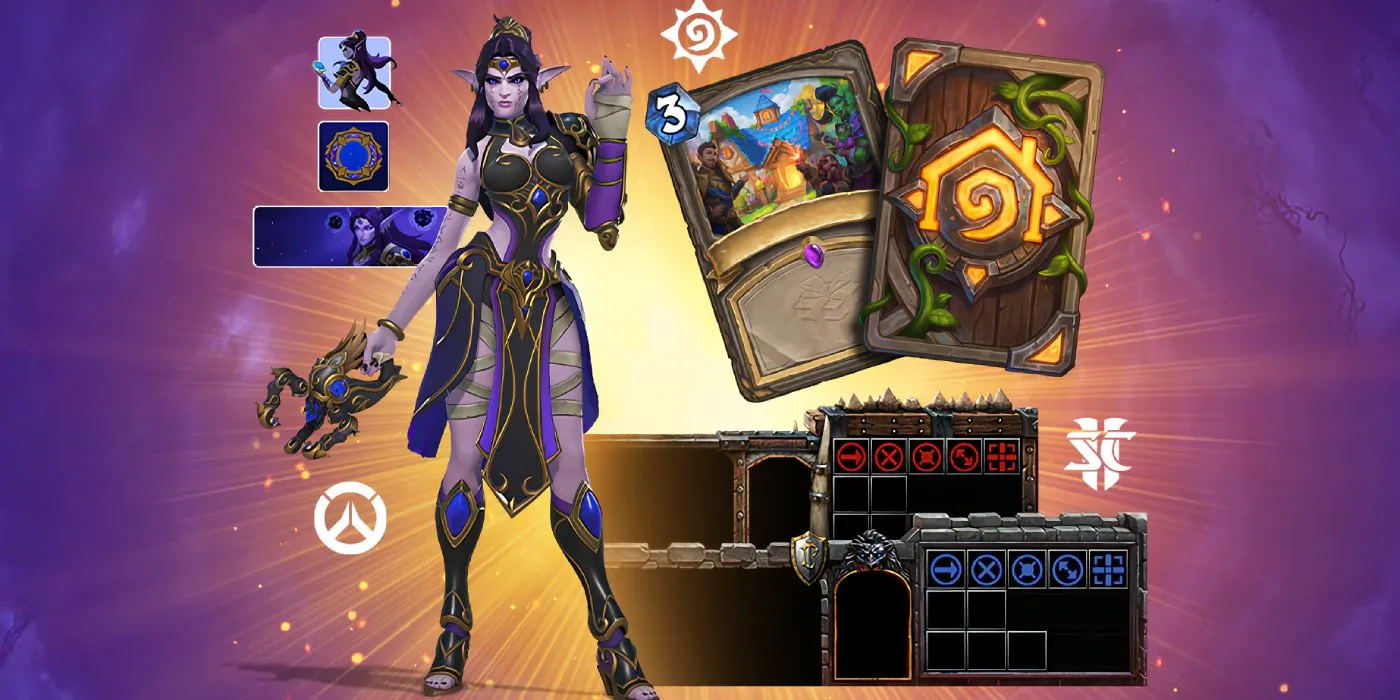Rock beats Scissors, Scissors beats Paper, Paper beats Rock.
Historically, all Hearthstone decks can be broken into 3 primary archetypes: Aggro (Rock), Control (Paper), and Combo (Scissors) decks. These overarching deck categories cover pretty much every deck that we have seen rise to popularity in each meta. In each metagame, Hearthstone decks of each type act as counterbalances to one another. My goal each week is to bring you a deck from each archetype that is performing at the top of the Standard Ranked meta with a brief overview, decklist, and how to beat these decks. The rule of Rock, Paper, Scissors defines which matchups are favorable and which are not, however, any deck can win any game if you play to your outs and understand your best chance to win a game.
Goals of Each Type
- Rock (Aggro) - defeat your opponent with early minion damage, board presence, and direct damage via minions or spells from hand.
- Paper (Control) - defeat your opponent by running them out of resources; health, minions, spells are all resources.
- Scissors (Combo) - defeat your opponent by playing cards which combine to create powerful effects for One-Turn-Kills or massive board-swings in single turns.
Weekly Overview
With the release of Saviors of Uldum, the metagame is still wildly cycling from day to day and will still take some time for the best decks to be refined and the meta to settle into a predictable state. This week's "Rock, Paper, Scissors" features the 3 most dominant decks in the current metagame. We feature 2 decks which are quite similar to their previous versions in Control Warrior and Conjurer's Calling Mage. The final deck is a new Murloc Paladin archetype that is the dominant aggro deck of the week.
Rock - Aggro
The term SMOrc comes to mind when I think of aggro (https://www.youtube.com/watch?v=-jenlSf2E8o)
Aggro is viewed as the most straightforward of the decktypes for a beginner to understand and play. Your goal is to kill your opponent before they have a chance to stabilize the board, keep their life total outside your damage from hand, and you run out of cards to play. Your goal with an aggressive deck is always to balance how much damage you are dealing to your opponent each turn and fight for control of the board at each stage. Aggro thrives against Combo decks which sacrifice board presence, removal, and healing in order to play powerful combinations of cards that can win them the game. Aggro suffers against Control which focuses on removing all of your minions, healing, and generating value so they have more resources at the end of the game.
Featured Deck of the Week: Tip the Scales Murloc Paladin
How to Play It
Murlocs have been an effective strategy in aggressive decks for a long time in Hearthstone. Murloc decks rely on putting a large number of murlocs on the board followed by buffs from Murloc Warleader, Coldlight Seer, and Grimscale Oracle, in order to deal damage to the opponent. If they run out of board clears you win the game. This deck relies heavily on the combination of Prismatic Lens + Tip the Scales, which will summon a full board of murlocs at a heavily discounted rate. You can find additional burst damage from Zephrys the Great and Sir Finley of the Sands once your deck is empty of duplicates. Additionally, Chef Nomi is your endgame condition to give you one final board once your deck is empty.
How to Beat It
This deck relies so heavily on the Prismatic Lens + Tip the Scales combination that if they never draw either you have a great chance at winning. However, this is unlikely, and they will flood the board with murlocs until they do draw one. Your key to winning the matchup is keeping in mind that they want to summon a full board of un-buffed health murlocs. You can tech in board clears with any deck to deal 2-3 damage and save it for when they summon a large board, this will let you get ahead on the board and keep the flood of murlocs in control long enough to deal lethal damage to the Murloc Paladin.
Paper - Control
Control is challenging because it takes practice to know what threats to expect from your opponent. The more knowledge you have of your opponent, the better you will perform. Control, typically, has a finite number of removal tools for individual minions and board clears. When playing this archetype each turn you have to ask yourself a few questions: Do I need to remove this minion/board right now? How can I stabilize this board to keep it from getting out of control? How do I prevent lethal damage from my opponents hand? By answering each of these questions, you learn when to clear a board and when to leave it, when you should be playing a taunt minion, and when you absolutely need to heal. Your end goal is how/when to stabilize and take full control of the game so your opponent cannot get back into the game. Control thrives against Aggro because eventually all Aggro decks run out of cards in hand or cards in their deck; meaning that if you can keep the board, they will run out of steam and lose. Control suffers against Combo because it often lacks proactive plays to deal damage to the opponent, allowing Combo to play their combo pieces whenever they want.
Featured Deck of the Week: Dr. Boom Control Warrior
How to Play It
If you love control and/or Warrior, there has rarely been a more dominant version of this deck. Anyone playing ladder at any level is familiar with the ever-present "Wallet-Warrior". Warrior has fantastic class cards in Shield Slam and Brawl to provide ever-present removal options. The constant removal in addition to armor mechanics that allow the warrior to gain health on top of their base health make Warrior incredibly difficult to kill. The key card that puts it over-the-top is Dr. Boom, Mad Genius; although after playing against it a few times, you are likely the one who is mad. Dr. Boom, Mad Genius gives all mechs played rush, making every minion in their deck a removal option. Dr. Boom, Mad Genius also allows the Warrior to discover more mechs, giving them even more removal. The Warrior will continue to play mechs, board clears, and removal until you run out of cards to play or cards in your deck. The final trump card is Archivist Elysiana which will shuffle 10 cards into their deck, while you start taking fatigue damage. A new taunt package in Armagedillo, Tomb Warden (which is a mech, by the way), and Frightened Flunky give the Warrior more resources to help them continue exhausting your resources.
How to Beat It
This is the hardest deck to beat in the game. They gain armor at absurd rates, making an OTK via damage much more difficult to achieve. Any aggro strategy must be careful to use resources incredibly frugally to make sure you don't run out. Most of the Warrior's strategy revolves around clearing your board up to 5 times with their board clears. This allows for decks which can make more than 5 big boards and deathrattle decks to win games in the long term. If you can create more boards than the Warrior can clear, you can win the game. If you can create situations where a board clear is not enough to win the board, you can win the game. However, you must play rather quickly, once Dr. Boom, Mad Genius gets going your odds go down dramatically. The deck with the best winrate against Control Warrior is the Quest Paladin which can develop endless big deathrattle mechs that the Warrior cannot clear, most other decks go even or struggle against this powerful edition of Control Warrior.
Scissors - Combo
Combo is sometimes classified more as a game of solitaire than a game of Hearthstone. Historically, combo decks are assembled in a way that once you complete each step, you win the game with a lethal in one turn, known as a One-Turn-Kill (OTK) deck. However, the current state of Hearthstone has very few decks which are capable of this. Most combo decks execute a series of plays to set up incredibly powerful boards by cheating out discounted cards or an infinite source of large minions (think Pogohopper Rogue and Conjurers Calling Mage). Combo decks thrive against control because the control deck often does little to nothing to threaten lethal against you. Combo suffers against aggro because by running combo cards, you sacrifice removal and healing; allowing aggro to beat you before you complete the combo. Once a combo deck has played it's combo cards, it is almost unstoppable.
Featured Deck of the Week: Luna's Pocket Galaxy Big Spell Mage
How to Play It
There are quite a few versions of the deck that are successful and vary in a few card choices. However, this deck has not changed strategy much with the addition of Saviors of Uldum. It still relies on getting as large a hand as possible to play Mountain Giant + Conjurer's Calling to develop incredibly large boards for as little as 6 mana. The buff of Luna's Pocket Galaxy to cost only 5-mana makes this the most powerful card in the deck, you can OTK your opponent or build a massive board over and over again. This combination of powerful discount effects is what makes the current version of Big Spell Mage so powerful. The final cherry-on-top of the deck is Puzzle Box of Yogg-Saron which can be used as an eject button or to generate additional resources, it may not have the best win-rate but it's certainly the most fun, new card in the deck. Your endgame, after stalling the early game, is a combination of [Hearthstone Card (Alexstraza) Not Found] + Kalecgos to reduce your opponents health and overwhelm them with a massive board built by Conjurer's Calling.
How to Beat It
Mage can take a long time to get online, which means that an aggressive strategy can lead to victory. They have limited healing via Zilliax and Ice Barrier, which makes dealing enough damage to them a distinct possiblity. The longer the game goes on, the harder it will be for you to close the game out. You can largely ignore their early-game minions to try to deal direct damage, except for Mountain Giant (which you should alwasy kill if you can due to the threat of Conjurer's Calling). By racing them to the finish, you are likely to win the game before they create a gigantic board to beat you. If they get an early Luna's Pocket Galaxy keep in mind that your job is much, much more challenging. If you are playing control against the Mage, keep track of how many big boards they can make and play your removal accordingly. You may also try to play more aggressively for damage with control if that is possible.
I hope you have enjoyed this week's edition of Rock, Paper, Scissors. Tune in next week for another 3 competitive decks of each archetype.
Have you encountered these decks or played them? Tell us about your experiences and share your thoughts below!




Comments
Yeah it's been great because outside of the good rolls, midrange hunter obliterates warrior with Dire Frenzy, Tundra Rhino, and Timber Wolf. 9 times out of 10.
I'm curious if you think Dr. Boom is more broken or Conjurer's Calling, just and an example of what you think is overpowered in Hearthstone.
I've played Midrange Hunter for the last 4 months as main deck and with solid results, so I know very well what you mean: yeah, if your opponent doesn't highroll with bombs, you should get the upper hand with the insane burst that Dire Frenzy can generate.
However, if played well it's still a 70/30 or so matchup (if you consider the Bomb archetype too; on the other hand, I agree with you that against a deck that doesn't create lots of pressure like Control Warrior building a fat Zul'jin is not a huge deal); moreover, having a bad matchup doesn't indicate that the card is ok: that's just looking at data and arriving at conclusion solely through them, and we don't want to do that. Right?
In fact, the biggest concern about Boom is how it feels to play against it and what it allows: yeah you can win, but at what cost? It usually feels like if you don't have a good play every turn you're gonna lose all your chances to win the game; it feels like that it doesn't matter what you do, your opponent will deny it and take control of the board at the same time. Always. That's what Control decks usually want to do, but this is on another level given the current situation in Standard. You can either flood the board every turn (Mage, partially Quest Druid) or burst them down (Mid Hunter). In the end, it feels like playing against Rexxar or Jaina: bad.
For the regards of Conjurer's Calling, this is what I repeat (every time the exact same words) when people ask me what I think about the card: "3 mana Conjurer's Calling is just a stupid card and shouldn't exist." I'm all in for classes to have powerful cards that allow powerful turns, because that's what define them, but the current situation of that card is just stupid: you can generate an (almost) invincible board by turn 6, creating a wall of big drops with little effort (Naga Sea Witch PTSD here). Again, it feels really bad to play against CC: if you don't have removal for every single threat, you're doomed, and sometimes it isn't even enough given that they can do that dumb shit in the same turn (thanks Luna's Pocket Galaxy, thanks Mana Cyclone, thanks Elemental Evocation a.k.a. pre nerf Innervate for Elementals).
I could go on with this, and I'd be glad if you wanted to continue the conversation, but I don't want to make this post too long since we are in a forum.
I end my reply answering you final question: both Boom and CC are both beyond broken, each one for its reason (with CC gameplan logic checks out, with Boom you can't expect to be leading the game anymore unless you're that far ahead that it doesn't almost matter what your opponent does).
I wanna underline this concept: having overpowered cards is ok (otherwise we would just play with vanilla minions), having stupid cards is not.
Oh I agree with pretty much everything here! I think Boom's biggest problem isn't so much his power but how he feels to play against, which is very much a matter of perception. If his mech pool were worse and not improved with the recent expansion, he wouldn't feel quite so awful to face. I think a lot of people think Boom needs a nerf because of specialist, but that was a bad format that rewarded playstyles a bit different from ranked play, so it's an unequal comparison when pros say "Boom is broken" and ranked players say "Yeah, see how it went in the tourney?" Boom needs a change, just not as urgently as other cards, so I don't see him as toxic, comparatively. The whole issue with mage is my precise sentiments, too. Those cards do not need to exist, and certainly need to cost more to mitigate their power.
Great job!!
But I prefer the terms aggro, midrange and control, since they sound less misleading.
Basically. Midrange is what happens when you take an Aggro deck, slow it down by adding some removal, and exchange some of the cheaper minions for beefier minions that have a better chance of surviving on the board while you work toward some kind of win condition: overwhelming board pressure, a combo, or simple attrition. There's a wide range of midrange decks, and some of them win faster than others, so I don't mind the definitions this article used as they're closer to rock-paper-scissors.
"Midrange" is a hybrid deck, not one of the three main archetypes.
Great article, thank you !
Great article to get people understanding archetypes and play styles.
Why do I get the feeling that Dr. Boom, Mad Genius is never going to get nerfed? I feel we are going to get the "we need more data" treatment until he rotates.
btw, they can't even touch the mana cost, as it would lose the consistency of the dr.7 meme-title.
Probably, the best way to nerf it is switching the Rush keyword with another one. Maybe Magnetic or Windfury.
Either way, for the meta to stay balanced, you are required to have Control in place at around t2.
So all in all they can't and they shouldn't destroy CW. What they should do is finding a way to not make it THE Control deck, whatever that way is.
He was the big signature card of a set. It's hard for Blizzard to nerf it without looking dumb. I agree that he could use it, but I'm saying that they will be hard pressed to as a matter of optics.
First of all, great article. It's a really good introduction to the concepts of deck archetypes. Remember midrange? Me neither. Midrange is basically just aggro.
I HATE Tip The Scales Paladin so much. Aggro decks aren't supposed to be able to draw through every card by turn 12. Not sure what needs to be done, but maybe a 1-mana nerf to Prismatic Lens, and a 1-draw nerf to Tastyfin.
As for control warrior, I like the community suggestion of nerfing Mad Genius by only giving Rush to the first Mech PLAYED each turn.
Alex should be moved to the Hall of Fame.
Well written article but I disagree with a couple things:
I don't feel like Pocket Galaxy Mage is a combo deck. It doesn't use any kind of combo to close the game out and win, it just kind of plays Pocket Galaxy and makes big tempo plays because the big minions now cost 1. So unless you're idea of a combo is Pocket Galaxy + any minion, then I don't see how this qualifies.
Secondly, I think Tip the Scales Pally does actually qualify as a combo deck. Since it requires a setup and uses Tip the Scales to actually swing the board and win the game outright.
Maybe we have different definitions of combo, but I still enjoyed the article. Great write-up!
The terms are very vague anyway
Combo is a bit of a fine line in terms of how a deck is set up and I decided to use a broader definition. I decided on Mage being combo because once the deck plays it’s key cards it pretty much just wins. There are multiple ways to set up lethal with combinations of cards, but it’s a deck that dies to aggro if it can’t get the combo off.
That's fair enough, after Pocket Galaxy I suppose the whole deck does just become combos
That Nomi Paladin tempts me so much... I have all the cards besides the epic spells and finley (which is optional i guess).
I play that deck Finley is eminently replaceable by another Murloc with a good body. I only get to play him with his Battlecry about 20% of the time, if that. More often than not, he gets sucked into play by Tip the Scales.
Nice list, but non of them are a match for my No Spells Highlander Mage!
Not exactly "no spells", because it has Book of Specters.